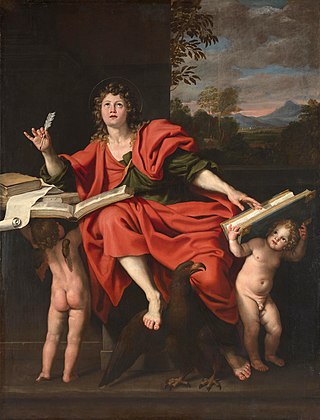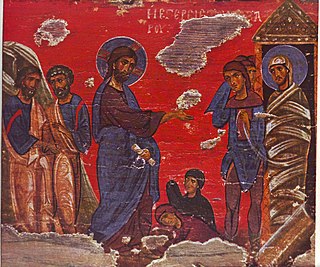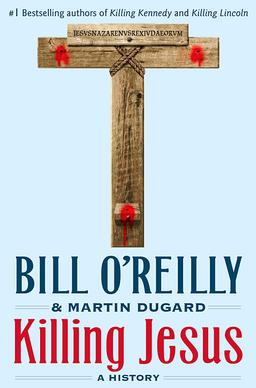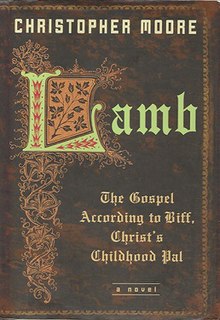
Mary Magdalene was a woman who, according to the four canonical gospels, traveled with Jesus as one of his followers and was a witness to his crucifixion and resurrection. She is mentioned by name twelve times in the canonical gospels, more than most of the apostles and more than any other woman in the gospels, other than Jesus' family. Mary's epithet Magdalene may mean that she came from the town of Magdala, a fishing town on the western shore of the Sea of Galilee in Roman Judea.

Mary of Bethany is a biblical figure mentioned only by name in the Gospel of John in the Christian New Testament. Together with her siblings Lazarus and Martha, she is described by John as living in the village of Bethany, a small village in Judaea to the south of the Mount of Olives near Jerusalem.

Christopher Moore is an American writer of comic fantasy. He was born in Toledo, Ohio. He grew up in Mansfield, Ohio, and attended Ohio State University and Brooks Institute of Photography in Santa Barbara, California.

Martha is a biblical figure described in the Gospels of Luke and John. Together with her siblings Lazarus and Mary of Bethany, she is described as living in the village of Bethany near Jerusalem. She was witness to Jesus resurrecting her brother, Lazarus.

Fisher Stevens is an American actor, director, producer and writer. As an actor, he is best known for his portrayals of Ben in Short Circuit and Short Circuit 2, Chuck Fishman on the 1990s television series Early Edition, and villainous computer genius Eugene "The Plague" Belford in Hackers. He portrays Marvin Gerard on NBC’s The Blacklist. His most recent successes include winning the 2010 Academy Award for Best Documentary Feature for The Cove and the 2008 Independent Spirit Award for Best Documentary Feature for Crazy Love. In addition, he has directed the documentary Before the Flood, which screened at the Toronto International Film Festival and by National Geographic on October 21, 2016. He stars as Hugo Baker on the HBO satirical drama series Succession.

Two names and a variety of titles are used to refer to Jesus in the New Testament. In Christianity, the two names Jesus and Emmanuel that refer to Jesus in the New Testament have salvific attributes. After the crucifixion of Jesus the early Church did not simply repeat his messages, but focused on him, proclaimed him, and tried to understand and explain his message. One element of the process of understanding and proclaiming Jesus was the attribution of titles to him. Some of the titles that were gradually used in the early Church and then appeared in the New Testament were adopted from the Jewish context of the age, while others were selected to refer to, and underscore the message, mission and teachings of Jesus. In time, some of these titles gathered significant Christological significance.

The Stupidest Angel: A Heartwarming Tale of Christmas Terror is a 2004 novel by American writer Christopher Moore. Set during Christmas, it brings together several favored characters from his previous books set in the fictional town of Pine Cove, a recurring location in Moore's novels.
Lamb or The Lamb may refer to:

The Gospel of Mary is a non-canonical text discovered in 1896 in a 5th-century papyrus codex written in Sahidic Coptic. This Berlin Codex was purchased in Cairo by German diplomat Carl Reinhardt.

Coyote Blue is a novel by American writer Christopher Moore, published in 1994.

The phrase "the disciple whom Jesus loved" or, in John 20:2; "the other disciple whom Jesus loved", is used six times in the Gospel of John, but in no other New Testament accounts of Jesus. John 21:24 states that the Gospel of John is based on the written testimony of this disciple.
Lamb of God is a term in Christian theology.

Shulim or Nikolai Aleksandrovich Notovich, known in the West as Nicolas Notovitch, was a Crimean Jewish adventurer who claimed to be a Russian aristocrat, spy and journalist.

Lazarus of Bethany, also venerated as Righteous Lazarus, the Four-Days Dead in the Eastern Orthodox Church, is the subject of a prominent sign of Jesus in the Gospel of John, in which Jesus restores him to life four days after his death. The Eastern Orthodox and Catholic traditions offer varying accounts of the later events of his life.
The Jesus bloodline refers to the proposition that a lineal sequence of descendants of the historical Jesus has persisted to the present time. The claims frequently depict Jesus as married, often to Mary Magdalene, and as having descendants living in Europe, especially France but also the UK. Differing and contradictory Jesus bloodline scenarios, as well as more limited claims that Jesus married and had children, have been proposed in numerous modern books. Some such claims have suggested that Jesus survived the crucifixion and went to another location such as France, India or Japan.

The Gospel According to Jesus Christ is a novel by the Portuguese author José Saramago. It is a fictional re-telling of Jesus Christ's life, depicting him as a flawed, humanised character with passions and doubts. The novel proved controversial, especially among the Roman Catholic Church, with the Vatican newspaper L'Osservatore Romano accusing Saramago of having a "substantially anti-religious vision". It was praised by other critics as a "deeply philosophical, provocative and compelling work".
Biff is a given name, a nickname or part of a stage name.

The unknown years of Jesus generally refers to the period of Jesus's life between his childhood and the beginning of his ministry, a period not described in the New Testament.
Ladies and Gentlemen, the Bible! is a book written by author and radio presenter Jonathan Goldstein. The book is a comedic retelling of the Old Testament stories such as Adam and Eve, Samson, Noah, and David and Goliath. Ladies and Gentlemen, the Bible! includes a story narrated by Joseph, who is skeptical of believing in Immaculate Conception, which was broadcast on the "Holiday Spectacular" episode of This American Life.

Killing Jesus: A History is a 2013 book by Bill O'Reilly and Martin Dugard about the life and crucifixion of Jesus, referred to in the book as Jesus of Nazareth. It is the follow-up to Killing Kennedy and Killing Lincoln. Killing Jesus was released September 24, 2013, through Henry Holt and Company.















